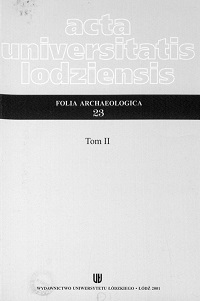Przyczynek do dziejów hutnictwa żelaznego na ziemi dobrzyńskiej
DOI:
https://doi.org/10.18778/0208-6034.24.08Abstrakt
In the northern part of the Dobrzyń Land, which since the 80s of the 13th century was within Rypin castellan's district and since the mid-14th century in the Rypin district, conditions were favourable for iron metallurgy development. Its source basis was constituted by turf ores lying on swampy meadows in the closest neighbourhood of Rypin and other areas of the castellan’s district, crossed by a number of streams (lowing into Rypienicą, Drwęca and Wkra rivers. Historical evidence testifies for functioning of five forges furnished with water wheels in this area. While searching for metallurgical settlements in areas rich in ores all notices about cereal mills being in use in modern times should be taken into account. According to Z. Guidon water smithy equipment from the 16th century was often rebuilt for cereal processing. One of such mills functioned in Mały Zakroczek, which is now included in the village of Dylewo. In the place where the mill worked as late as in the inter-war period, nowadays there are fishponds. Archaeologists’ attention was drawn by finds of medieval clay vessels and lumps of iron slag dug from the bottom of the river. In 2000 excavations on the area of 74 sq m were conducted in order to recognize possible settlement traces. Despite considerable transformation of the discussed terrain, which took place during the latest rebuilding of the ponds, the archaeologists succeeded in revealing relics of the forge. Preserved layers of roasted ore, iron slabs, accompanied by layers of burning from blast furnaces testify for its functioning. On the grounds of pottery sherds and stove tiles the forge has been dated to a period from the end of the 13th to the end of the 17th century. During the production local turf ores were used. The location of the productive settlement on the river was not accidental; water wheel was probably used as propulsion of bellows and mechanisms for ore crumbling. After the iron production had been given up water mechanisms were successfully adapted by the mill.
Pobrania
Pobrania
Opublikowane
Jak cytować
Numer
Dział
Licencja

Utwór dostępny jest na licencji Creative Commons Uznanie autorstwa – Użycie niekomercyjne – Bez utworów zależnych 4.0 Międzynarodowe.












